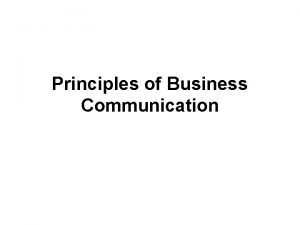Gladys NzitaMak Principles of effective communication General Cultural




- Slides: 4

Gladys Nzita-Mak Principles of effective communication

General Cultural differences When addressing your audience, through your work or speaking aloud, you will need to make sure that you do not offend a particular culture for example using hand signs are inappropriate language that certain cultures are offended by. What ever information you’re giving out may be acceptable in one culture, but it may not be the same for every other. You might need to choose more suitable words than the words you may normally use. Modulating voice Speaking out to an audience may be a little difficult. You’ll need to keep interest in your audience, and by doing so you may be required to raise your voice to be heard, or would need to set a certain tone in your voice in order to keep your audience interested. When speaking out to your audience, stick to the subject and be clear on what you’re explaining, for example if you’re doing a presentation based on computer hardware, stick to that topic and only explain the main points you as a speaker would want the audience to take in and always make sure that whatever you're explaining can be understood by the audience.

Interpersonal Techniques & Cues When verbally communicating change of tone is necessary. Speaking in a lowered voice may show fear or even insecurity. � Speaking in a raised voice may indicate anger or impatience. � When communicating face to face, body language is very important. � Folded arms may be hard to avoid, but it shows that you are not interested in what’s going on, but in this case, what is being said. Even though you may be speaking to someone through a telephone, it is still possible that they can identify your emotion through the tone of your voice, for instance if you were to be speaking in a dull uninterested voice, the person you are speaking to may be offended as you are not even bothered to help them. � Active Engagement Communication isn’t just done when you are speaking, it can be done whilst another person is speaking too. This can be done by a nod or a frown and showing that you are actually acknowledging what the other person is saying, the person speaking will see your reaction and take note that you are listening. When the speaker has finished, they may signal you so you can be able to respond. The speaker might end with a short question like ‘what do you think? ’ or even give you signals through body language to let you know you can give your point of views to what they have just said. You can show that you’ve understood what has just been said by summarising a few points they have just shared, and following up to this you can add in your own comments.

Written communication skills Guidelines Being an employee, you are expected to follow organisational guidelines and procedures. � You will be assigned space to work in, and be given equipment to work with (a computer, telephone etc. ) � You will be given a timetable to notify you when to come in, and also when to be available for others to contact you. � Templates will be available to use for written communication � Be aware of the guidelines of how to use computer equipment (e. g. information booklets) Smiley’s and Emoticons and smiley's are used to represent how the person is feeling. They are used whilst on internet social websites like Twitter and Facebook and in text messages. They should not be used in serious communications for example when sending letters to an employer, you would want to seem serious and professional, whereas adding them in would make you look the exact opposite.







